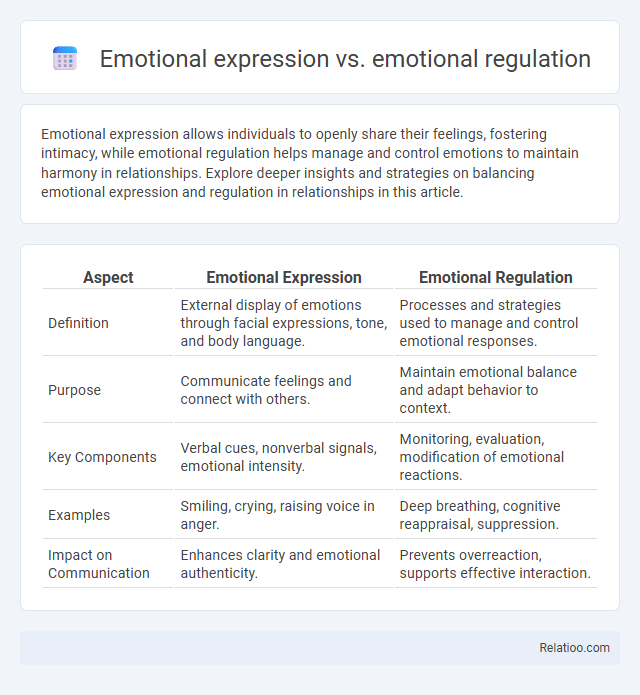Emotional expression allows individuals to openly share their feelings, fostering intimacy, while emotional regulation helps manage and control emotions to maintain harmony in relationships. Explore deeper insights and strategies on balancing emotional expression and regulation in relationships in this article.
Table of Comparison
| Aspect | Emotional Expression | Emotional Regulation |
|---|---|---|
| Definition | External display of emotions through facial expressions, tone, and body language. | Processes and strategies used to manage and control emotional responses. |
| Purpose | Communicate feelings and connect with others. | Maintain emotional balance and adapt behavior to context. |
| Key Components | Verbal cues, nonverbal signals, emotional intensity. | Monitoring, evaluation, modification of emotional reactions. |
| Examples | Smiling, crying, raising voice in anger. | Deep breathing, cognitive reappraisal, suppression. |
| Impact on Communication | Enhances clarity and emotional authenticity. | Prevents overreaction, supports effective interaction. |
Introduction to Emotional Expression and Regulation
Emotional expression involves the outward display of your feelings through facial expressions, vocal tone, and body language, serving as a crucial channel for social communication. Emotional regulation refers to the processes by which you influence the intensity, duration, and type of emotions experienced, ensuring adaptive responses to various situations. Understanding the balance between emotional expression and regulation is essential for maintaining psychological resilience and fostering healthy interpersonal relationships.
Defining Emotional Expression
Emotional expression refers to the outward display of feelings through facial expressions, body language, and vocal tone, serving as a primary way humans communicate their internal states. Emotional regulation involves managing and modifying these emotional responses to achieve desired outcomes, while emotional modulation focuses on adjusting intensity and duration of emotions to maintain psychological balance. Understanding your emotional expression enhances self-awareness and improves interpersonal communication by conveying genuine feelings effectively.
Understanding Emotional Regulation
Emotional regulation involves managing and modifying emotional responses to achieve adaptive outcomes, distinguishing it from emotional expression, which is the outward display of feelings. Effective emotional regulation enhances mental health by reducing impulsive reactions and promoting balanced decision-making. Understanding emotional regulation requires recognizing strategies such as cognitive reappraisal and mindfulness that help control intensity and duration of emotions.
Key Differences Between Expression and Regulation
Emotional expression involves outwardly displaying feelings through facial expressions, body language, or vocal tones, while emotional regulation refers to managing and modifying those emotions internally to respond appropriately to different situations. The key difference lies in expression being the visible manifestation of emotions and regulation being the cognitive control over emotional responses. Your ability to balance expression and regulation impacts emotional well-being and social interactions.
Benefits of Healthy Emotional Expression
Healthy emotional expression supports mental well-being by allowing you to communicate feelings authentically, reducing stress and preventing emotional build-up. Unlike emotional regulation, which involves managing and controlling feelings to respond appropriately, emotional expression provides relief and fosters empathy in relationships. Embracing healthy expression promotes resilience, enhances self-awareness, and improves overall psychological health.
Importance of Emotional Regulation in Daily Life
Emotional regulation plays a crucial role in managing your responses to various situations by controlling and modulating emotional intensity, unlike emotional expression, which is the outward display of feelings. Effective emotional regulation enhances mental well-being, reduces stress, and improves decision-making in daily life. Developing this skill helps maintain healthy relationships and promotes resilience against emotional challenges.
Challenges in Balancing Expression and Regulation
Balancing emotional expression and emotional regulation presents significant challenges because expressing emotions openly can sometimes conflict with the need to regulate feelings for social appropriateness or personal well-being. You may struggle to find the right level of emotional expression that allows authenticity without causing misunderstandings or emotional overwhelm. Effective emotional regulation strategies involve recognizing triggers, managing physiological responses, and adapting expression to fit the context, fostering healthier interpersonal relationships and mental health.
Cultural Influences on Emotions
Emotional expression varies widely across cultures, influencing how individuals display feelings such as happiness, anger, or sadness in social contexts. Emotional regulation involves culturally learned strategies that guide how you manage and modify your emotional reactions to fit social norms and expectations. Understanding cultural influences on emotions reveals that emotional expression and regulation are deeply intertwined processes shaped by societal values and traditions, impacting your emotional experiences and interpersonal relationships.
Strategies for Enhancing Emotional Skills
Emotional expression involves openly conveying feelings through words, facial expressions, or body language, essential for authentic communication and relationship building. Emotional regulation refers to managing and modulating emotional responses to maintain psychological balance, often utilizing strategies like mindfulness, cognitive reappraisal, and deep breathing. Enhancing emotional skills can be achieved by practicing self-awareness, developing empathy, and employing techniques such as journaling and emotion labeling to improve both expression and regulation effectively.
Impact on Mental Health and Relationships
Emotional expression involves openly communicating feelings, which fosters authenticity and strengthens relationships by building trust and empathy. Emotional regulation refers to managing and modifying emotional responses, crucial for maintaining mental health by reducing stress, anxiety, and impulsivity. Imbalanced emotional regulation, either by suppression or excessive expression, can negatively impact mental well-being and strain interpersonal connections, highlighting the importance of adaptive emotional skills for psychological resilience and healthy social interactions.

Infographic: Emotional expression vs Emotional regulation
 relatioo.com
relatioo.com